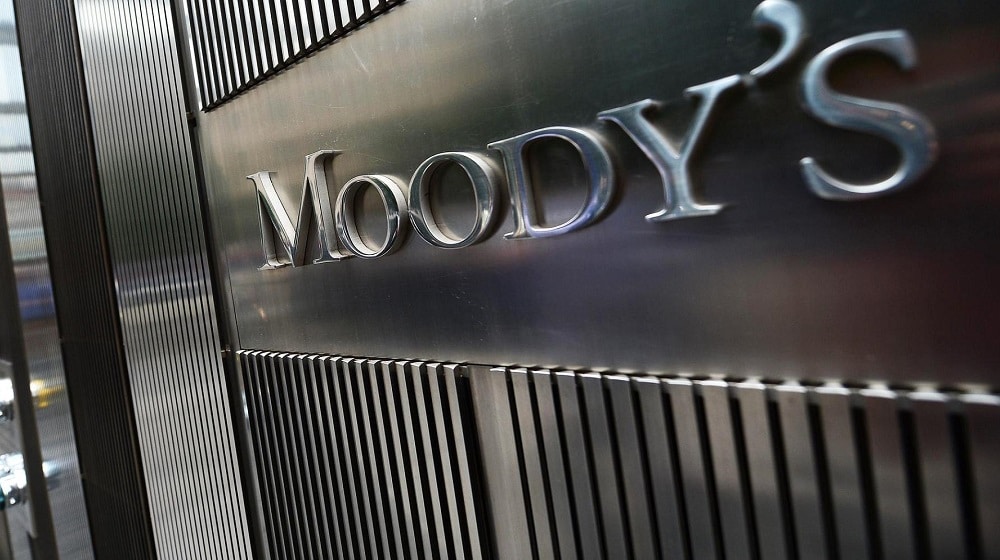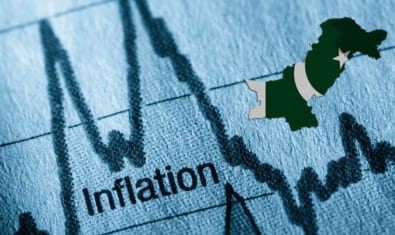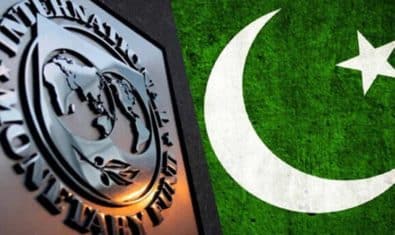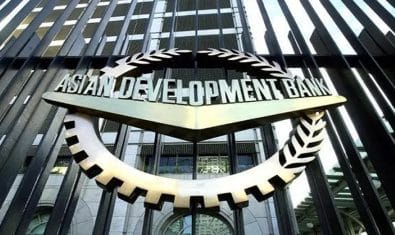The economic and political uncertainty will challenge the pace of Pakistan’s fiscal consolidation in the fiscal year 2023, says Moody’s Investors Services (Moody’s).
The credit rating agency in its latest report “Government of Pakistan – B3 negative, Annual credit analysis, overview, and outlook”, stated that the credit profile of Pakistan reflects its low fiscal strength, weak institutions and governance strength, heightened external vulnerability risks, and elevated political risks, balanced against a large economy and robust growth potential.
The social risk in the country is also highly negative, reflecting low household incomes, limited access to quality healthcare and basic services, and ongoing safety concerns in the country that limit investment opportunities said the rating agency in the report.
Pakistan’s external vulnerability risk has risen and has been amplified by rising inflation, which adds stress to the current account, the currency, and foreign-exchange reserves, especially during heightened political and social risk, it added.
The negative outlook is driven by Pakistan’s heightened external vulnerability risk and uncertainty around the sovereign’s ability to secure additional external financing to meet its needs. The negative outlook signals that a rating upgrade is unlikely over the near term, it added.
The outlook could be changed to stable if Pakistan’s external vulnerability risks decreased significantly and durably. This could come from access to substantial external financing that significantly raises foreign-exchange reserves. A resumption of fiscal consolidation, including through the implementation of revenue-raising measures, pointing to a significant improvement in debt affordability would also be credit positive.
Conversely, the rating could be downgraded if there were further deterioration in Pakistan’s external position that would threaten the government’s external repayment capacity and balance of payments stability. This could come from protracted negotiations with the IMF, resulting in delays in securing additional financing from the IMF or other sources beyond 2022.
Expectations that government debt would rise markedly, with a related deterioration in debt affordability from an already weak level, could also lead to a rating downgrade. An increase in social and political risk that disrupted policymaking and undermined Pakistan’s ability to secure financing would also be negative for the rating.
Pakistan’s solid potential growth of about 5 percent in part reflects the country’s favorable demographics with a sizable population of people under 30 years of age. Nonetheless, Pakistan’s potential growth is constrained by structural challenges, including weak governance and low competitiveness.
Pakistan’s economy is large but low per capita incomes constrain its shock-absorption capacity. With nominal GDP of nearly $350 billion as of the fiscal year ended June 2021 (fiscal 2021), Pakistan is the fourth-largest economy among sovereigns in the B-rating range. Its relatively large economy affords Pakistan some diversification from local or sector-specific shocks, providing credit support. However, a very low GDP per capita of around $6,000 on a purchasing price parity (PPP) basis – ranking it in the bottom 20 percent of rated sovereigns – constrains the sovereign’s credit profile by limiting its shock-absorption capacity.
Near-term growth to slow on the back of high inflation and monetary tightening The report expects real GDP growth to moderate to around 3.5-4 percent in fiscal 2023, amid higher borrowing costs, and erosion in real incomes because of higher inflation, and tighter fiscal policy.
Pakistan’s position as a net oil and food importer has exposed the country to recent surges in global commodity prices, driving a sustained increase in inflation. SBP’s current policy rate is 15 percent. Moody’s expects the central bank to continue to increase rates over 2022 because of ongoing elevated inflationary pressures, as well as because the current negative real rates may not be sufficient to support import compression.
Along with tightening monetary policy and high inflation, the government has also introduced measures to dampen import demand, notably by banning the imports of nonessential and luxury items such as luxury motor vehicles and cosmetics. Against this backdrop, the report predicts growth in private consumption and private investments to slow, while manufacturing activity could weaken amid higher utility and raw materials costs. These segments of the economy had similarly moderated over 2018-19 amid similarly high inflation and aggressive monetary tightening by the SBP.
Government consumption growth could increase in fiscal 2023 as the next general elections near and preelection spending rises, which would provide support to growth. Higher government spending during election years is consistent with historical patterns. During the 2013 and 2018 elections, government consumption rose 10.1 percent and 5.5 percent year on year, respectively elevated social tensions associated with the current high inflationary environment could challenge the government’s ability to sustain reform momentum.
However, in recent years, progress in the development of the CPEC appears to have stalled, with several projects running behind schedule. Security concerns stemming from terror attacks, accumulating arrears owed to investors, and economic and political difficulties have driven an exodus of Chinese labor and capital, hindering the progress of several projects. Nonetheless, the current government has signaled its commitment to making faster progress on the CPEC, including establishing and operationalizing the SEZs. However, the government’s ability to execute projects may be limited by its weak fiscal strength, which has worsened since 2015, when the economic corridor was introduced.
We expect further progress in the CPEC to take some time. Therefore, we currently factor in limited productivity benefits from the CPEC. Meanwhile, we expect that the other reforms – such as GST base harmonization, further rationalizing the trade tariff structure, and boosting the efficiency of the SOE sector – that Pakistan is undertaking to improve its competitiveness will likely proceed slowly because of the current more challenging political environment, read the report.
International surveys of various indicators of governance, while showing some early signs of improvement, continue to point to weak rule of law and control of corruption, as well as limited government effectiveness. These weaknesses are balanced against Pakistan’s efforts in improving its macroeconomic policy effectiveness in recent years. the government has amended the State Bank of Pakistan Act to strengthen the independence of the central bank and restrict the central bank from extending credit to the government.
Ongoing initiatives, if sustained, would improve the quality of governance over time Among rated sovereigns, Pakistan ranks around or below the bottom 20 percent in the Worldwide Governance Indicators (WGI) for government effectiveness, control of corruption, rule of law, regulatory quality and voice and accountability, corresponding to our assessment of weak institutions and governance. The country’s rankings have fluctuated around current levels over the past decade and its scores remain low relative to B-rated peers, but consistent with those at a similar level of development such as Bangladesh.
Moody’s projects headline inflation to average around 18-20 percent in fiscal 2023, as fuel and energy subsidies are reversed and additional petroleum levies are imposed. It also expects headline inflation to fall sharply to 9-10 percent in fiscal 2024 due to high base effects and as food and energy prices moderate.
The high debt-servicing requirements associated with the large stock of debt also reduce the fiscal flexibility to undertake key expenditures on infrastructure and social initiatives. The foreign-currency portion of outstanding general government debt is around one-third of total government debt, which exposes the government’s balance sheet to foreign-exchange risks. However, the large share of concessional funding of the foreign currency-denominated debt mitigates roll-over and debt affordability risks on the government’s foreign-currency obligations.
The authorities budgeted general government (consolidated federal and provincial operations) expenditure at Rs. 12.7 trillion (15.5 percent of our forecast 2023 nominal GDP), which is 17 percent higher than the estimated spending for fiscal 2022.
While expenditure is substantially higher compared with the previous year, much of the increase arises from higher foreign loan repayments in the capital account (including a $1 billion Sukuk maturity in December 2022). Other aspects of the expenditure components increased only moderately, in line with the government’s austerity drive. Current spending is budgeted at Rs. 8.7 trillion, just 2.1 percent above the estimated amount for fiscal 2022.
In particular, total subsidies are budgeted to be 56 percent lower than estimated in fiscal 2022, led by a 54 percent decline in utility subsidies and a more than 80 percent drop in petroleum subsidies. Functionally, the lower subsidies are reflected in much less spending on economic programs (particularly in the fuel and energy category), while health-related spending declined sharply, presumably because of the phasing out of coronavirus-related support measures and expenses. These cuts were offset against an around 11 percent rise in budgeted spending for general public services, which was driven by a nearly 26 percent increase in debt-service payments.
Broadly, the report determines the fiscal deficit to come in at around 5.5-6.5 percent of GDP for fiscal 2023, narrowing moderately from the 7.1 percent estimated for fiscal 2022.
“Our projection is more conservative than the government’s estimated deficit of 4.9 percent for fiscal 2023 as announced in the Budget. While several tax-enhancing measures were introduced as part of the Budget, we think that the highly inflationary environment and related economic hardships will weigh on growth (as mentioned above, we project fiscal 2023 growth at 3.5 percent-4.0 percent compared with 5.0 percent government estimates) and consequently negatively affect the revenue outlook,” it added.
In addition, there may be some challenges in the implementation of the tax-enhancing measures. The social cost associated with higher inflation the country heads into the next election due by mid-2023 could constrain the government’s capacity to sustainably pursue austerity measures. For example, the government has set to collect petroleum levies worth Rs. 855 billion for fiscal 2023, from an estimated Rs. 135 billion in fiscal 2022.
To achieve this target, it will require the government to remove all subsidies on petroleum and impose levies of Rs. 50 per liter of petrol from Rs. 10 per liter at present. The government could find it difficult to continually raise the petroleum levy over the next fiscal year, especially because of the impact it would have on the already elevated cost of living.
We expect deficits to narrow once economic conditions stabilize and reform momentum returns with greater political clarity after the next general elections, the report stated. The government debt burden remains elevated along with weak debt affordability Slower fiscal consolidation suggests that the government’s debt burden will remain higher for longer. We project government debt to gradually decline back to 2017-18 levels of around 60 percent over the next four to five years from our estimate of around 70 percent of GDP in fiscal 2022, similar to the level recorded in fiscal 2021, it added.
While Moody’s expects Pakistan’s government debt to decline over the medium term, the country’s debt burden will remain above the median for similarly rated sovereigns because of a very narrow revenue base and high debt burden, Pakistan’s government debt as a share of revenue is very high at around 560 percent in fiscal 2021 and at an estimated 650 percent in fiscal 2022.
The firm also expects this ratio to remain high at 550 percent-590 percent over fiscal 2023-24. Additionally, debt affordability – as measured by interest payments/revenue – will continue to be a credit constraint and remain weak at 45-50 percent of revenue in fiscal 2022-24 because of an increasingly tight monetary environment and a narrow government revenue base.
The government’s balance sheet is subject to contingent liability risks, largely in the form of circular debt in the power sector held by the Central Power Purchasing Authority (CPPA) and the Power Holding Private Limited (PHPL), as well as debts from other loss-making SOEs. More broadly, the government reports that its total guaranteed and nonguaranteed public sector enterprises’ debt and liabilities amount to about 6 percent of GDP as at end of fiscal 2021. The circular debt stock has continued to increase over the past three years. The debt stock rose to Rs. 2.28 trillion ($12.9 billion, about 4.1 percent of GDP) in fiscal 2021, from Rs. 2.15 trillion in fiscal 2020, and is about double the debt stock of Rs. 1.15 trillion at the end of fiscal 2018. A reduction in the circular debt stock will lower the government’s contingent liabilities.
The current government will likely persist with reforms to reduce the circular debt stock, although because of the heightened political uncertainty, it is unclear how quickly the government will proceed with associated reforms.
Our assessment of political risk at “b” reflects a material probability of a recurrence in domestic political stress that will impinge on the effectiveness of policymaking and the government’s ability to implement timely economic reforms aimed at achieving macroeconomic stability. Despite the installation of the new government, Moody’s assesses that political instability remains high.
While political and policy uncertainty could recede temporarily after the next election, there is a significant probability of a recurrence in domestic political stress that will impinge on the effectiveness of policymaking and the government’s ability to implement timely economic reforms aimed at achieving macroeconomic stability.
Political risks related to the social and economic cost of rising inflation have also risen substantially over the past few months. Pakistan has very high gross borrowing requirements, which Moody’s projects at around 20 percent of GDP for fiscal 2022 and fiscal 2023, driven by its still sizable fiscal deficits and high exposure to short-term debt.





















